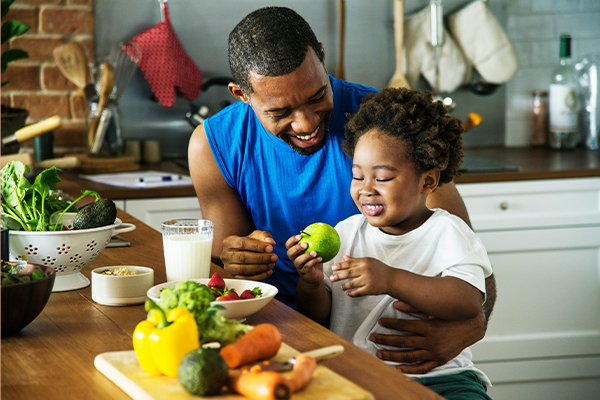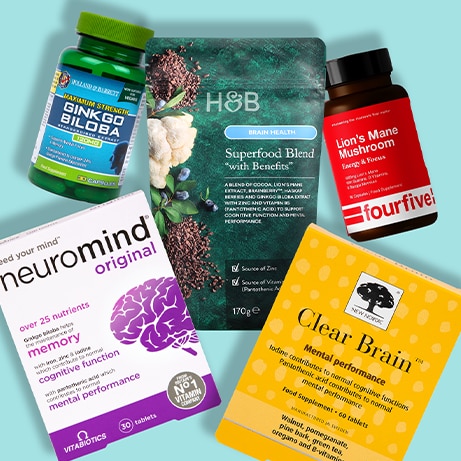15% off £25 or 20% off £35
Code:BASKET
Food for thought: The best brain foods for kids

From oily fish to leafy greens, some foods do more than fill tummies, they help nourish curious minds. Discover the everyday foods packed with nutrients that support your child’s brain development
Summary
1Why does kids' nutrition matter?
Just like their growing body, your child’s developing brain needs the right nutrition to keep working in tip-top order - not just for the...
2What makes it a ‘brain food’?
Iron, omega-3s, iodine, zinc and B vitamins all play a role in supporting children’s normal brain function and development…
3What are the best brain foods for kids?
Think oily fish, leafy greens, beans, eggs and fortified cereals — everyday foods rich in the nutrients growing minds need…
Our kids’ brains grow at an incredible pace, with the foundations for cognitive, social and emotional development built in the first few years of life. And those busy little brains need the right fuel to function at their best.1
The good news? Fuelling your child’s brain by feeding them a healthy meal with essential nutrients doesn’t have to be complicated. Keep reading for simple, no-fuss ways to add food for the brain to your child’s diet – no dinner table battles required.
Why nutrition matters for your kids’ brain health
Just like their growing body, your child’s developing brain needs the right nutrition to keep working in tip-top order – not just for the short term, but also to help them thrive in the future.2
Right from the start, nutrition plays a vital role. In fact, the human brain changes a lot within the first years of life. While most newborn babies don’t show complex skills like multitasking or memory, their brains are already busy building connections needed for these abilities before they’re even born. Talk about working overtime.3
This rapid development demands a steady supply of nutrients, fueling everything from cognition and learning to memory, focus and even emotional growth.3
And just like scaffolding supports a building, each stage of brain development builds on the one before it. So, those early years of nutrition are essential – they lay the foundations for everything that comes next.2
What makes a food a ‘brain food’?
You know that good nutrition is vital for your kid’s brain, especially when they’re very young. But how do you know which foods actually support brain function?
Let’s take a closer look at some of the nutrients that fuel your child’s brain development.1
Just a note: the nutrients we cover below are intended for children who are beyond the breastfeeding and formula-feeding stages.
Let’s start with a pretty important one: iron, which contributes to the normal cognitive development of children.4
In fact, research shows that iron may support brain growth and neural connections. It also plays a role in energy production and neurotransmitter function, both of which are essential for movement and mental performance.1
The European Food Safety Authority (EFSA) confirms that iron is vital for cognitive development in children – right through to age 18. However, it’s particularly important during the first three years of life.4
We need iron most during periods of fast growth – stages of life like infancy, early childhood and adolescence. It's essential for everyone.5
Docosahexaenoic acid (DHA) is an omega-3 long-chain fatty acid essential for normal brain function in infants and children.6
Our body can make DHA from other types of omega-3s, but it can only do this in small amounts, so we need to get most of the DHA we need through diet.7 And, since the brain absorbs high amounts of DHA, especially in the first two years of life, ensuring your child gets enough can support their healthy development.6
Iodine is crucial for making thyroid hormones, which play a key role in brain development.
Getting enough iodine during pregnancy is especially important for your baby’s brain.1
The EFSA confirms that iodine is essential for growth and development, with evidence showing that adequate iodine intake could help prevent iodine deficiency disorders, which can impact both mental and physical development.8
Research suggests zinc helps protect cells from oxidative stress, supports normal cognitive function, and contributes to fertility and reproduction (plus much more). An early deficiency may affect learning, attention, memory and mood.1
According to the EFSA, zinc is essential for normal growth in infants and young children.9 While deficiency is unlikely with a balanced diet, zinc supplements may help maintain healthy growth and development if one does happen.9 Always consult a healthcare professional before introducing any supplements into your child’s diet.
Evidence suggests that certain B vitamins, like vitamin B12, are important for brain development and cognitive function.10
B12 is essential for a healthy brain and nervous system. Getting enough vitamin B12 into your child’s diet will help maintain normal brain and nerve function.11
Protein is made up of amino acids, which act as building blocks for our bodies.12
We all need slightly different protein amounts depending on things like gender, life stage, exercise levels, and whether you’re recovering from an illness or surgery.13,14 It’s also recommended that protein intake is increased during pregnancy and breastfeeding, where protein needs are especially high.15
What are the best brain foods for kids?
Kids can get iron from meat and fish, or from plant-based foods like leafy green vegetables, beans and lentils. Fortified breakfast cereals are also a great option for an extra boost.16
Oily fish is a win when it comes to omega-3 fatty acids (like DHA).17 Nuts, seeds, vegetable oils (flaxseed and soybean), soya and soya products like soy milk are also good sources of omega-3 fatty acids.7
Protein-rich foods like meat, fish, beans, pulses, eggs and tofu are all fantastic choices. The NHS recommends offering at least one serving of meat or fish per day or two plant-based protein sources. Nuts are a tasty option too, though if your child is under five, whole nuts should be avoided as a choking hazard, so aim for nut butters instead.16
For vitamin B12, try including meat, fish, milk, cheese, eggs, yeast spreads and some fortified breakfast cereals in their meals.18
Your kids should be able to get all the zinc they need from a varied diet, with sources including meat, dairy products (like cheese) and wholegrain bread.19 Other plant-based sources of zinc include tofu, tempeh, beans, lentils, whole grains, nuts and seeds.20
The same goes for iodine, which can be found in dairy, eggs, fish and fortified plant-based drinks.21
Now that you know what food for the brain looks like, how can you easily add these options to your child’s daily meals?
How to incorporate brain foods into your kid’s diet
Nourishing your child’s brain is a long-term investment in their cognitive, social and emotional wellbeing.2 As with any healthy eating habit, it’s a good idea to follow some tried-and-tested advice:22

- be a role model for your child by eating brain-healthy foods alongside them
- get creative with cooking, encouraging your child to pick out nutritious recipes they might enjoy (depending on their age)
- as they get older, talk to them about the importance of balancing different food groups, including ‘brain food’ options
Healthy eating should be both enjoyable and sustainable, so why not try starting small and gradually adding more food for the brain to your child’s diet?
The final say
Giving your child’s brain the right nutrition is one of the best ways to support their development during those crucial early years. By including a variety of ‘brain foods’ in their diet – like essential vitamins and minerals, omega-3 fatty acids and iron – you’re helping fuel brain growth and lay the groundwork for memory, attention and cognitive skills.1
Whether it’s adding extra leafy greens to their meals or aiming for two healthy protein sources per day, these simple, everyday choices could have a lasting impact.11
A well-fed brain is a thriving brain – why not start today?1
Disclaimer - This article provides informational advice and is not a substitute for medical care. Curated by experts for accuracy, we take great care to ensure the information is up-to-date and relevant. However, you should always consult your GP or healthcare professional before using supplements or alternative products, particularly if you have medical conditions or are under supervision.
1. Cusick S, Georgieff M. The role of nutrition in brain development: The golden opportunity of the “first 1000 days”. J Pediatr. 2016;175:16–21. https://pmc.ncbi.nlm.nih.gov/articles/PMC4981537/
2. Georgieff M. Early life nutrition and brain development: breakthroughs, challenges and new horizons. Proc Nutr Soc. 2023;82(2):104–112. https://doi.org/10.1017/s0029665122002774
3. Georgieff M, et al. Nutritional influences on brain development. 2018;107(8):1310–21. https://pmc.ncbi.nlm.nih.gov/articles/PMC6045434/
4. EFSA Panel on Dietetic Products, Nutrition and Allergies (NDA). Scientific Opinion on the substantiation of a health claim related to iron and contribution to normal cognitive development under Article 14 of Regulation (EC) No 1924/2006. EFSA J. 2013;11(7):3335. https://www.efsa.europa.eu/en/efsajournal/pub/3335
5. BDA. Iron factsheet [Internet]. [cited 2025 Apr 4]. Available from: https://www.bda.uk.com/resource/iron-rich-foods-iron-deficiency.html
6. EFSA Panel on Dietetic Products, Nutrition and Allergies (NDA). Scientific Opinion on the substantiation of a health claim related to DHA and contribution to normal brain development pursuant to Article 14 of Regulation (EC) No 1924/2006. EFSA J. 2014;12(10):3840. https://www.efsa.europa.eu/en/efsajournal/pub/3840
7. National Institutes of Health (NIH). Omega-3 fatty acids [Internet]. NIH [reviewed 2022 Jul 18; cited 2025 Apr 4]. Available from: https://ods.od.nih.gov/factsheets/Omega3FattyAcids-Consumer/
8. EFSA Panel on Dietetic Products, Nutrition and Allergies (NDA). Scientific Opinion on the substantiation of a health claim related to iodine and contribution to normal cognitive development pursuant to Article 14 of Regulation (EC) No 1924/2006. EFSA J. 2014;12(1):3517. https://www.efsa.europa.eu/en/efsajournal/pub/3517
9. EFSA Panel on Dietetic Products, Nutrition and Allergies (NDA). Scientific Opinion on the substantiation of a health claim related to zinc and normal growth pursuant to Article 14 of Regulation (EC) No 1924/2006. EFSA J. 2014;12(11);3891. https://www.efsa.europa.eu/en/efsajournal/pub/3891
10. Venkatramanan S, et al. Vitamin B-12 and cognition in children. Adv Nutr. 2016;7(5):879–88. https://doi.org/10.3945/an.115.012021
11. EFSA Panel on Dietetic Products, Nutrition and Allergies (NDA). Scientific Opinion on the substantiation of health claims related to vitamin B12 and contribution to normal neurological and psychological functions (ID 95, 97, 98, 100, 102, 109), contribution to normal homocysteine metabolism (ID 96, 103, 106), maintenance of normal bone (ID 104), maintenance of normal teeth (ID 104), maintenance of normal hair (ID 104), maintenance of normal skin (ID 104), maintenance of normal nails (ID 104), reduction of tiredness and fatigue (ID 108), and cell division (ID 212) pursuant to Article 13(1) of Regulation (EC) No 1924/2006. EFSA J. 2010;8(10):1756. https://efsa.onlinelibrary.wiley.com/doi/pdf/10.2903/j.efsa.2010.1756
12. Qin P, et al. ‘A review on plant-based proteins from soybean: Health benefits and soy product development.’ Journal of Agriculture and Food Research. 2022;7(7):100265. Available from: https://doi.org/10.1016/j.jafr.2021.100265.
13. Public Health England. Government Dietary Recommendations Government recommendations for energy and nutrients for males and females aged 1 - 18 years and 19+ years [Internet]. [Cited 2025 Apr 4]. Available from: https://assets.publishing.service.gov.uk/media/5a749fece5274a44083b82d8/government_dietary_recommendations.pdf
14. NHS. The importance of protein in your diet [Internet]. [Cited 2025 Apr 4]. Available from: https://www.berkshirehealthcare.nhs.uk/media/109513434/importance-of-protein-in-diet-bhp220.pdf.
15. EFSA Panel on Dietetic Products, Nutrition and Allergies (NDA). Scientific opinion on dietary reference values for protein. EFSA J. 2012;10(2):2557. https://efsa.onlinelibrary.wiley.com/doi/epdf/10.2903/j.efsa.2012.2557
16. NHS. What to feed young children [Internet]. [cited 2025 Feb 24]. Available from: https://www.nhs.uk/conditions/baby/weaning-and-feeding/what-to-feed-young-children
17. NHS. Fish and shellfish [Internet]. [cited 2025 Feb 24]. Available from: https://www.nhs.uk/live-well/eat-well/food-types/fish-and-shellfish-nutrition
18. NHS. Vitamins and minerals: B vitamins and folic acid [Internet]. [cited 2025 Feb 24]. Available from: https://www.nhs.uk/conditions/vitamins-and-minerals/vitamin-b/
19. NHS. Vitamins and minerals: Others [Internet]. [cited 2025 Feb 24]. Available from: https://www.nhs.uk/conditions/vitamins-and-minerals/others/
20. National Institutes of Health. Zinc [Internet]. [cited 2025 Apr 5]. Available from: https://ods.od.nih.gov/factsheets/Zinc-HealthProfessional/
21. NHS. Vitamins and minerals: Iodine [Internet]. [cited 2025 Feb 24]. Available from: https://www.nhs.uk/conditions/vitamins-and-minerals/iodine/
22. NHS. Feeding and eating: Healthy eating [Internet]. [cited 2025 Feb 24]. Available from: https://www.cambspborochildrenshealth.nhs.uk/feeding-and-eating/healthy-eating/












